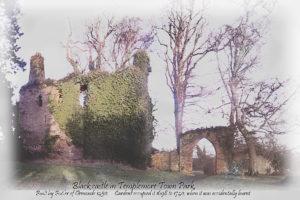
The name Templemore, An Teampall Mór, derives from a church built in the Town Park. It is a planned town which owes its existence to the Cardens. This family, who came from Cheshire, purchased land from the Butlers and lived in the Butler Castle in the Park until it was accidentally destroyed by fire. Its ruins, known as the Black Castle, can be seen to this day.
The Cardens then lived in a house called The Priory. About 1856 The Priory was rebuilt and was then known as The Abbey.The Cardens laid out the Park with its artificial lake. Planned features of the town include a wide market square to facilitate the holding of fairs and markets, a market house, tree lined avenues and terminal buildings on most roads. Leading off the main streets were lanes and narrow alleys, with such interesting names as Polygon Lane, Pickfoot Lane and Preaching Lane. The Cardens insisted that all the houses on the main streets would have slate roofs.
The building of the military barracks commenced c. 1810, opened in 1813 and this was significant for the growth and development of the town. Some fine Georgian houses were built to accommodate military personnel and some of the old street names commemorated the British victories of the Peninsular Wars of the early 18th century and the important military commanders of the time. Sir John Carden had 37 new houses built on what was called New Row, to accommodate weavers from Belfast. However, they did not stay, and the houses were then occupied by local people. These houses were demolished in the 1940s.

The population of the town grew rapidly in the mid 19th century as people flocked in from the country to obtain food and work. The Sisters of Mercy established a foundation in 1863 and their contribution to the town in the field of education and social services has been much acclaimed. The Irish Christian Brothers arrived in 1932 and they too made a significant contribution to the high standard of education available both at primary and second level. Service at St. Mary’s Church of Ireland began in 1790. The Church of the Sacred Heart, built on the site of an Erasmus Smith School donated by Sir John Carden, was opened for worship in 1883. These churches are part of the rich architectural heritage of the town.
The Military Barracks was the training ground for many regiments of soldiers going to the battlefields of the Great War. About two thousand German prisoners of war were held there for a short period in 1914-1915. The early 1920s was a dark period in the town’s history, with the activities of the Black and Tans and Auxiliaries, the burning of the Abbey vacated by the Carden family in 1902, the shooting dead of District Inspector W. H. Wilson and the burning of the Town Hall and other property. The former military barracks is now the campus of the Garda College, the national centre for police training, since February 1964.


John Morrissey. 1831-1878, was a successful bareknuckle boxer who became a Democratic State Senator in the U.S. and a U.S. Congressman for New York. He built the Saratoga Race Course in New York.

Fr. Francis Gleeson. 1884 – 1959, served as an army chaplain in the First World War and was highly regarded for his ministry at the battlefront with The Munster Fusiliers. He was the subject of a painting by Fortunino Matania, giving the troops absolution on the eve of the Battle of Aubers Ridge.

J.K. Bracken. 1852 – 1904, was a committed Nationalist, and one of the seven founding members of the Gaelic Athletic Association in 1884. He was a gifted monumental sculptor and some of his work can be seen around Ireland, including The Maid of Erin monument in Kilrush.